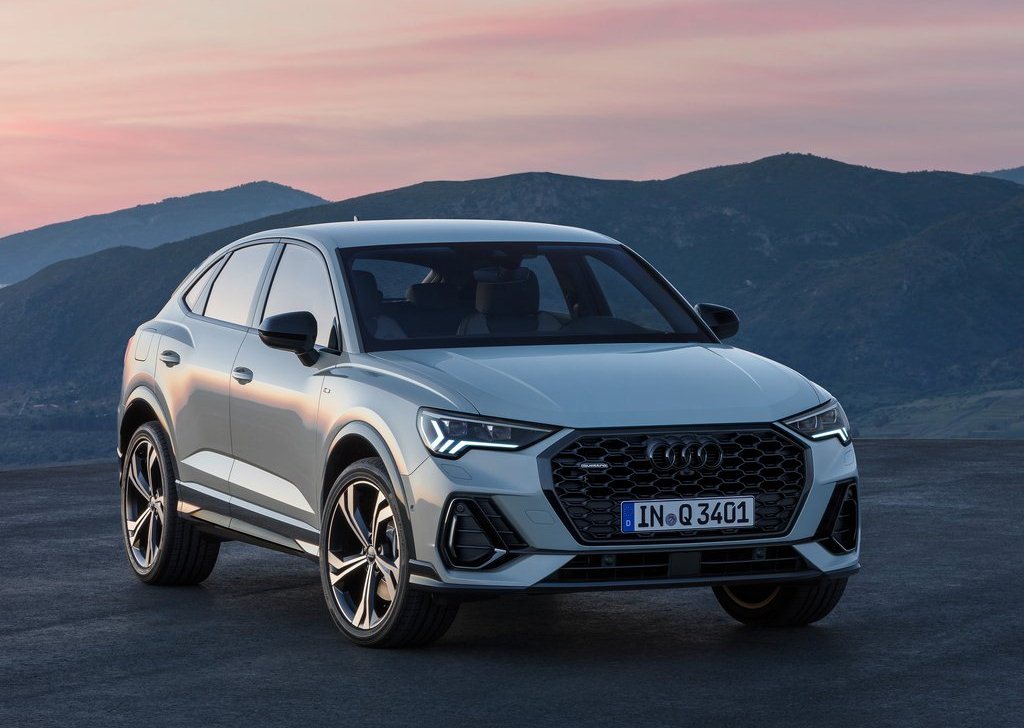The Audi Q3 Sportback stands for strength and precision to an equal degree, and reflects this in all design details. The black grille of the octagonal Singleframe is strongly three-dimensional in design, and this makes it particularly sporty. The same applies for the trapezoidal air inlets and the expressive bumper with its flat blade. The coupé-like passenger cabin acts as a contrast to the distinctive attachments, which are painted in contrasting colors and thus emphasize the SUV character. The low roofline gives way to flat D-pillars and ends in a roof edge spoiler. As a result, the Audi Q3 Sportback appears much longer than its sister model Q3. In addition, the SUV-coupé is almost three centimeters flatter, and thus has a more muscular appearance. Above the wheels, strong contours draw attention to the quattro drive, which comes as standard with most engines. Many light and shadow effects arise on the plastic-formed rear. The low window, flanked by aero trims, and the sporty bumper, which takes up the look of the air inlets, emphasize the width of the Audi Q3 Sportback. The reversing lights contribute to this as well: they run inwards in a tapered shape, just like the flat headlights. Audi supplies the latter in three versions up to Matrix LED technology, whose adaptive high beam intelligently illuminates the road as best suits the driving situation.
TFSI, TDI, S tronic, quattro: the drive
For the market launch in Europe, a gasoline and a diesel engine are available for selection for the Audi Q3 Sportback. With 169 kW (230 metric hp), the 2.0 TFSI is the most powerful engine. The 2.0 TDI has an output of 110 kW (150 metric hp). Shortly after market launch, it will also be available as a manual transmission with a quattro drive. Additional engines will follow in the course of the year, including a more powerful diesel and an entry-level gasoline engine, which works together with a 48 V mild-hybrid system. During deceleration, it recovers energy; during acceleration from low speeds, it supports the engine. In real-life driving, it can save up to 0.4 l of fuel per 100 km (62.1 mi). In the top engines, the quattro all-wheel drive takes on the job of force transmission as standard. Its central component is a hydraulic multi-plate clutch on the rear axle. Its electronic management combines outstanding stability and strong traction with a high level of driving enjoyment. At the limits of performance, the quattro drive works closely together with the wheel-selective torque control, It makes handling even more dynamic and stable by means of gentle brake interventions on the inside wheels with the quattro drive and the inside front wheel with the front drive.
Digital world: Displays and operation
The operating and display concept proves how Audi is pushing ahead with digitalization: Even the basic equipment includes a digital instrument cluster with a 10.25-inch screen diagonal, which the driver operates using the multifunction steering wheel. In the top-of-the-line system, MMI navigation plus, the displays appear in the Audi virtual cockpit, which offers many additional functions. A touch display measuring 10.1 inches is positioned in the center of the instrument panel. When a function is selected, it emits acoustic feedback. Just like in the brand's full-size class models, it is surrounded by wide, high-gloss black trim. Together with the air-conditioning control unit located beneath it, the display is ergonomically tilted 10° towards the driver. On request, the 12.3-inch Audi virtual cockpit plus is available with three selectable layouts, including a particularly dynamic view. The flat menu structure is complemented by a control unit that uses natural language and can also understand free wordings. Entering a navigation destination and the MMI search are based on free text input. The system recognizes the driver's most frequent destinations based on previous journeys, allowing it to generate suitable suggestions. When doing so, it takes into consideration statistical empirical values regarding the traffic load and time of day.


















0 Comments